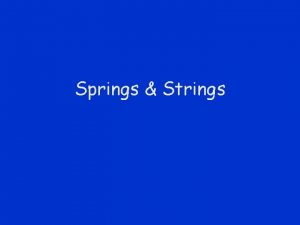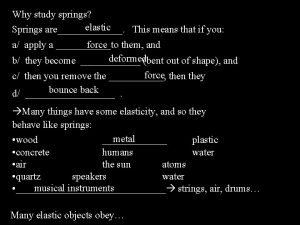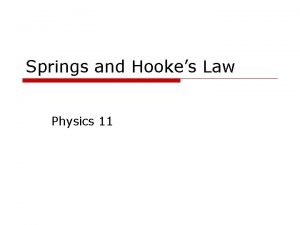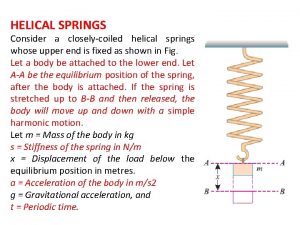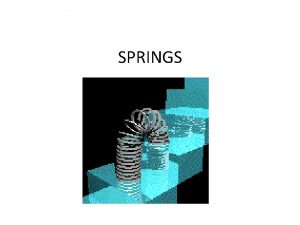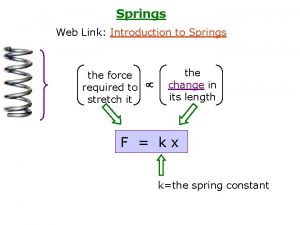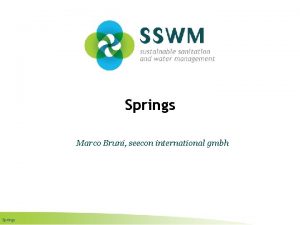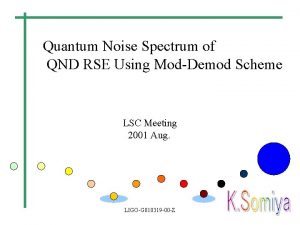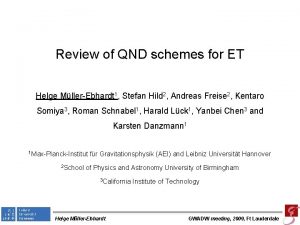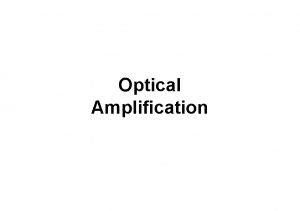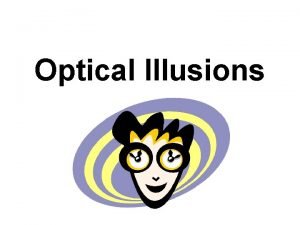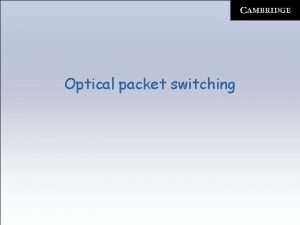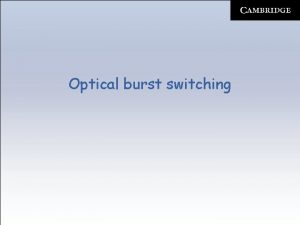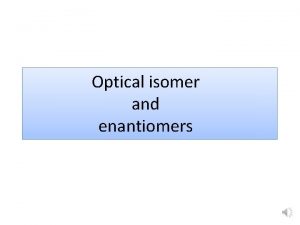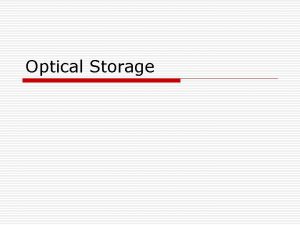Optical Springs at the 40 m QND Workshop


























- Slides: 26

Optical Springs at the 40 m QND Workshop, Hannover Dec 14, 2005 Robert Ward for the 40 m Team Osamu Miyakawa, Rana Adhikari, Matthew Evans, Benjamin Abbott, Rolf Bork, Daniel Busby, Hartmut Grote, Jay Heefner, Alexander Ivanov, Seiji Kawamura, Michael Smith, Robert Taylor, Monica Varvella, Stephen Vass, and Alan Weinstein Optical Springs at the 40 m

Caltech 40 meter prototype interferometer An interferometer as close as possible to the Advanced LIGO optical configuration and control system § Detuned Resonant Sideband Extraction (DRSE) § Power Recycling § Suspended mass ØSingle pendula § Digital controls system § Same cavity finesse as Ad. LIGO baseline design Ø 100 x shorter storage times. Optical Springs at the 40 m

Ad. LIGO signal extraction scheme ETMy 4 km § f 2 § § ITMy PRM BS ITMx 4 km ETMx Mach-Zehnder will be installed to eliminate sidebands of sidebands. Only + f 2 is resonant on SRC. Unbalanced sidebands of +/-f 2 due to detuned SRC produce good error signal for Central part. f 1 SRM -f 2 § § Carrier (Resonant on arms) -f 1 f 2 • Single demodulation • Arm information • Double demodulation • Central part information Arm cavity signals are extracted from beat between carrier and f 1 or f 2. Central part (Michelson, PRC, SRC) signals are extracted from beat between f 1 and f 2, not including arm cavity information. Optical Springs at the 40 m

The Story So Far To understand why we saw the optical springs in the way we have, it helps to know the story of Lock Acquisition at the 40 m. Optical Springs at the 40 m

40 m Lock Acquisition part I: Off-resonant lock scheme for a single cavity Transmitted light is used as Resonant Lock Off-resonant Lock point Optical Springs at the 40 m

40 m Lock acquisition procedure Start with no DOFs controlled, all optics aligned. ITMy 166 MHz ITMx 13 m MC BS 33 MHz PRM SP 33 PO DDM SRM SP 166 SP DDM AP 166 AP DDM Optical Springs at the 40 m

40 m Lock acquisition procedure 1/sqrt(Tr. Y) DRMI + 2 arms with offset Average wait : 3 minute (at night, with tickler) ITMy 166 MHz ITMx 13 m MC 33 MHz BS PRM T =7% SP 33 SP 166 I SP DDM Q SRM T =7% AP 166 AP DDM Optical Springs at the 40 m PO DDM 1/sqrt(Tr. X)

40 m Lock acquisition procedure Short DOFs -> DDM DARM -> RF signal CARM -> DC signal CARM -> Digital CM_MCL servo 1/sqrt(Tr. X)+ 1/sqrt( Tr. Y) Alternative path + ITMy 166 MHz -1 DARM + ITMx 13 m MC 33 MHz CARM BS PRM SP 33 SP 166 SP DDM PO DDM SRM To DARM AP 166 AP DDM Optical Springs at the 40 m AP 166 / (Tr. X+Tr. Y)

40 m Lock acquisition procedure Reduce CARM offset: 1. Go to higher ARM power 2. Switch on AC-coupled analog CM_AO servo, using REFL DC as error signal. 3. Switch to RF error signal (POX) at half-max power. 4. Reduce offset/increase gain of CM_AO. -1 ITMy 166 MHz GPR=5 13 m MC ITMx BS SP 166 33 MHz PRM PO DDM SRM SP 33 5. Packup MOPA and send it to LLO for S 5 DARM SP DDM REFL To DARM AP 166 AP DDM Optical Springs at the 40 m AP 166 / (Tr. X+Tr. Y)

Optical spring in detuned RSE was first predicted using two-photon formalism. h a : input vacuum b : output D: M: h : strain h. SQL: standard quantum limit t: transmissivity of SRM k: coupling constant F: GW sideband phase shift in SRC b: GW sideband phase shift in IFO laser h D Signal recycling mirror a b z: homodyne phase A. Buonanno, Y. Chen, Phys. Rev. D 64, 042006 (2001) Optical Springs at the 40 m

Detune Cartoon IFO DARM/CARM • IFO Differential Arm mode is detuned from resonance at operating point slope related to spring constant? Carrier frequency Sideband amplitude [a. u. ] FWHM SRC fsig LSB USB frequency offset from carrier [Hz] DARM • IFO Common Arm mode is detuned from resonance at intial locking point • Responses of GW USB and GW LSB are different due to the detuning of the signal recycling cavity. PRC Optical Springs at the 40 m CARM 11

DARM TFs as CARM offset is reduced Optical Springs at the 40 m

CARM optical springs • Solid lines are from TCST • Stars are 40 m data • Max Arm Power is ~80 • Also saw CARM anti-springs, but don’t have that data Optical Springs at the 40 m

Optical spring and Optical resonance in differential arm mode of detuned RSE • Optical gain of L- loop DARM_IN 1/DARM_OUT divided by pendulum transfer function • Optical spring and optical resonance of detuned RSE were measured. • Frequency of optical spring depends on cavity power, mass, detuning phase of SRC. • Frequency of optical resonance depends on detuning phase of SRC. • Theoretical line was calculated using A. Buonanno and Y. Chen’s equations. Optical Springs at the 40 m

Positive spring constant • SRM is locked at opposite position from anti-resonant carrier point(BRSE). • Optical spring disappeared due to positive spring constant. Broadband SR Optical Springs at the 40 m Broadband RSE

Simple picture of optical spring in detuned RSE Let’s move arm differentially, X arm longer, Y arm shorter from full RSE Wrong SRM position Correct SRM position BRSE Power(W) X arm Y arm Power(W) Y arm DARM (Lx-Ly) § § § Power X arm down, Y arm up Radiation pressure X arm down, Y arm up Spring constant Negative(optical spring) DARM (Lx-Ly) X arm down, Y arm down X arm up, Y arm down N/A Optical Springs at the 40 m Positive(no optical spring)

elationship between the CARM and DARM springs a § With the 40 m Lock Acquisition scheme, we only see a CARM spring if th § Details tomorrow • Using the DC-locking scheme for the arms, there are, prima facie, four locking points corresponding to the four possible gain combinations, but only two will acquire lock. Correct SRM position Incorrect SRM position Xarm Yarm DARM CARM + + x x + + 0 - - - 0 + - - x x + - - + x x Optical Springs at the 40 m 17

Will it lock? • x-axis: EY position • y-axis: signal • blue: X err • green: Y err • black: DARM • red: CARM NO modeled with FINESSE YES Optical Springs at the 40 m

DRMI lock using double demodulation with unbalanced RF sideband in SRC Carrier 33 MHz 166 MHz ITMy BS ITMx Unbalanced 166 MHz PRM DDM PD 33 MHz Belongs to next carrier SRM OSA DDM PD OSA Optical Springs at the 40 m Belongs to next carrier

Unbalanced Sideband Detection v. Can not be used to circumvent the standard quantum limit, due to heterodyne noise v. Can be used to change the measurement quadrature, and thus reshape the GW response b 2 § demodulation phase +166 MHz sideband § Kentaro Somiya “Photodetection method using unbalanced sidebands for squeezed quantum noise in a gravitational wave interferometer” PHYSICAL REVIEW D 67, 122001 2003 A. Buonanno, Y. Chen, N. Mavalvala, “Quantum noise in laser-interferometer gravitational-wave detectors with a heterodyne readout scheme” PHYSICAL REVIEW D 67, 122005 2003 b 1 Optical Springs at the 40 m

Changing the DARM quadrature 1. 2. 3. 4. 5. 6. Story: Lock IFO with CARM offset Handoff DARM to RF Adjust RF demodulation phase Reduce CARM offset This changes the quadrature of the signal. As we are not compensating for this by adjusting the demod phase, the shape of the response changes. May also be some overall gain change due to imperfect normalization Optical Springs at the 40 m

Optickle Results • GW response in a single, chosen quadrature at multiple CARM offsets Optical Springs at the 40 m

Why is the correct SRM position harder to lock? §The correctly detuned SRC doesn’t lock as easily as the oppositely tuned SRC §True for both full IFO and just the DRMI (though less noticeable on DRMI) §For full IFO, lock time goes from 1 to 5 minutes. §Have we just not tuned-itup it right yet? Optical Springs at the 40 m

Mode healing/injuring at Dark Port Negative spring constant with optical spring Positive spring constant with no optical spring Carrier power at DP is 10 x smaller • Repeatable • The same alignment quality Optical Springs at the 40 m

Compensating the resonances UGFs ~ 250 Hz Compensation Filters for the various resonances: Optical DARM CARM Opto-mechanical 4 k. Hz >> UGF no compensation Ad. LIGO: 180 Hz ~ UGF 40 Hz < UGF no compensation Ad. LIGO: 70 Hz? 1 k. Hz -> 100 Hz ~ UGF dynamic compensation 0 ->100 Hz ~ UGF not coherently compensated Optical Springs at the 40 m

DARM loop: Calibration questions D C S DARM Cavity response Sensing DARM_IN 1 EXC DARM_IN 2 P pendulum Use DARM_IN 1 A Actuator Feedback filter F • Measure DARM_IN 2/EXC= • Estimate S • Measure (or estimate) C DARM_OUT Use DARM_OUT • Measure DARM_IN 1/EXC= • Estimate A • Estimate P Optical Springs at the 40 m
 Chúa yêu trần thế alleluia
Chúa yêu trần thế alleluia Hươu thường đẻ mỗi lứa mấy con
Hươu thường đẻ mỗi lứa mấy con đại từ thay thế
đại từ thay thế Diễn thế sinh thái là
Diễn thế sinh thái là Vẽ hình chiếu vuông góc của vật thể sau
Vẽ hình chiếu vuông góc của vật thể sau Công thức tiính động năng
Công thức tiính động năng Tỉ lệ cơ thể trẻ em
Tỉ lệ cơ thể trẻ em Thế nào là mạng điện lắp đặt kiểu nổi
Thế nào là mạng điện lắp đặt kiểu nổi Lời thề hippocrates
Lời thề hippocrates Vẽ hình chiếu đứng bằng cạnh của vật thể
Vẽ hình chiếu đứng bằng cạnh của vật thể Quá trình desamine hóa có thể tạo ra
Quá trình desamine hóa có thể tạo ra độ dài liên kết
độ dài liên kết Các môn thể thao bắt đầu bằng tiếng chạy
Các môn thể thao bắt đầu bằng tiếng chạy Khi nào hổ mẹ dạy hổ con săn mồi
Khi nào hổ mẹ dạy hổ con săn mồi Hình ảnh bộ gõ cơ thể búng tay
Hình ảnh bộ gõ cơ thể búng tay Dạng đột biến một nhiễm là
Dạng đột biến một nhiễm là điện thế nghỉ
điện thế nghỉ Biện pháp chống mỏi cơ
Biện pháp chống mỏi cơ Trời xanh đây là của chúng ta thể thơ
Trời xanh đây là của chúng ta thể thơ Gấu đi như thế nào
Gấu đi như thế nào Thiếu nhi thế giới liên hoan
Thiếu nhi thế giới liên hoan Tia chieu sa te
Tia chieu sa te Một số thể thơ truyền thống
Một số thể thơ truyền thống Thế nào là hệ số cao nhất
Thế nào là hệ số cao nhất Hệ hô hấp
Hệ hô hấp Slidetodoc
Slidetodoc Số nguyên tố là gì
Số nguyên tố là gì
































